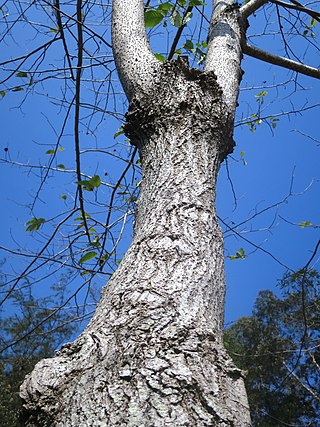
Camptotheca is a genus of medium-sized deciduous trees growing to 20 metres (66 ft) tall, native to southern China and Tibet. The genus is usually included in the tupelo family Nyssaceae, but sometimes included in the dogwood family Cornaceae.

Kaempferol (3,4′,5,7-tetrahydroxyflavone) is a natural flavonol, a type of flavonoid, found in a variety of plants and plant-derived foods including kale, beans, tea, spinach, and broccoli. Kaempferol is a yellow crystalline solid with a melting point of 276–278 °C (529–532 °F). It is slightly soluble in water and highly soluble in hot ethanol, ethers, and DMSO. Kaempferol is named for 17th-century German naturalist Engelbert Kaempfer.
N-acetyllactosamine synthase is a galactosyltransferase enzyme. It is a component of lactose synthase This enzyme modifies the connection between two molecule UDP-galactose and N-actyl-D-glucosamine and generates two different molecules UDP and N-acetyllactosamine as products. The main function of the enzyme is associated with the biosynthesis of glycoproteins and glycolipids in both human and animals. In human, the activity of this enzyme can be found in Golgi apparatus.
In enzymology, a cyanohydrin beta-glucosyltransferase is an enzyme that catalyzes the chemical reaction

In enzymology, a flavonol 3-O-glucosyltransferase is an enzyme that catalyzes the chemical reaction
In enzymology, a fucosylgalactoside 3-alpha-galactosyltransferase is an enzyme that catalyzes the chemical reaction
In enzymology, a galactosylxylosylprotein 3-beta-galactosyltransferase is an enzyme that catalyzes the chemical reaction
In enzymology, a glycoprotein-N-acetylgalactosamine 3-beta-galactosyltransferase is an enzyme that catalyzes the chemical reaction
In enzymology, an indolylacetyl-myo-inositol galactosyltransferase is an enzyme that catalyzes the chemical reaction
In enzymology, a kaempferol 3-O-galactosyltransferase is an enzyme that catalyzes the chemical reaction
In enzymology, a lactosylceramide beta-1,3-galactosyltransferase is an enzyme that catalyzes the chemical reaction
In enzymology, a xylosylprotein 4-beta-galactosyltransferase is an enzyme that catalyzes the chemical reaction

Beta-1,4-galactosyltransferase 7 also known as galactosyltransferase I is an enzyme that in humans is encoded by the B4GALT7 gene. Galactosyltransferase I catalyzes the synthesis of the glycosaminoglycan-protein linkage in proteoglycans. Proteoglycans in turn are structural components of the extracellular matrix that is found between cells in connective tissues.

The phenolic content in wine refers to the phenolic compounds—natural phenol and polyphenols—in wine, which include a large group of several hundred chemical compounds that affect the taste, color and mouthfeel of wine. These compounds include phenolic acids, stilbenoids, flavonols, dihydroflavonols, anthocyanins, flavanol monomers (catechins) and flavanol polymers (proanthocyanidins). This large group of natural phenols can be broadly separated into two categories, flavonoids and non-flavonoids. Flavonoids include the anthocyanins and tannins which contribute to the color and mouthfeel of the wine. The non-flavonoids include the stilbenoids such as resveratrol and phenolic acids such as benzoic, caffeic and cinnamic acids.

Kaempferide is an O-methylated flavonol, a type of chemical compound. It can be found in Kaempferia galanga. It has been noted to inhibit pancreatic cancer growth by blockading an EGFR-related pathway.

Hyperoside is a chemical compound. It is the 3-O-galactoside of quercetin.

Syringetin is an O-methylated flavonol, a type of flavonoid. It is found in red grape, in Lysimachia congestiflora and in Vaccinium uliginosum. It is one of the phenolic compounds present in wine.

Laricitrin is an O-methylated flavonol, a type of flavonoid. It is found in red grape and in Vaccinium uliginosum. It is one of the phenolic compounds present in wine.
Consolida oliveriana is a plant species in the genus Consolida. The plant is native to Iran, Iraq, and Turkey.
Glucosylceramide beta-1,4-galactosyltransferase is an enzyme with systematic name UDP-alpha-D-galactose:beta-D-glucosyl-(1<->1)-ceramide 4-beta-D-galactosyltransferase. This enzyme catalyses the following chemical reaction









